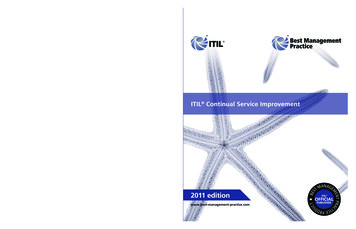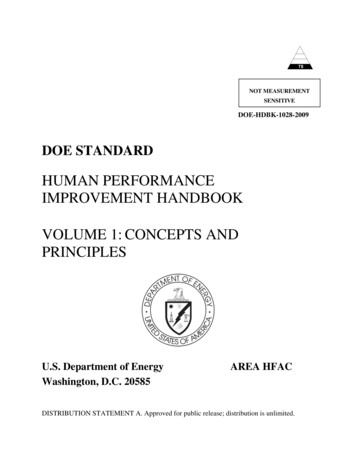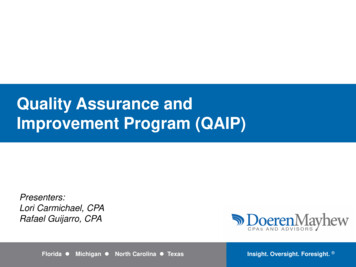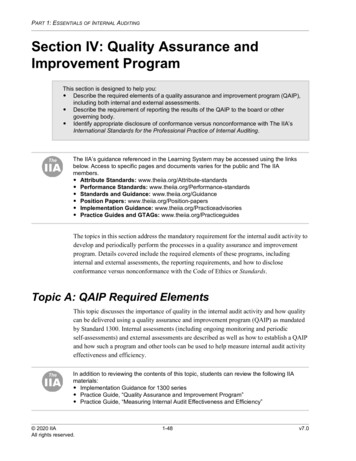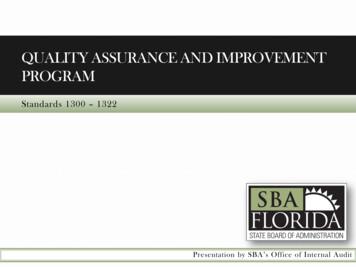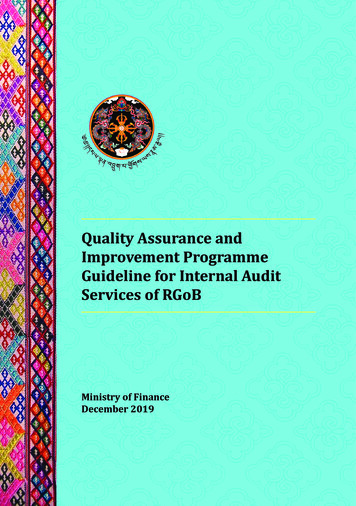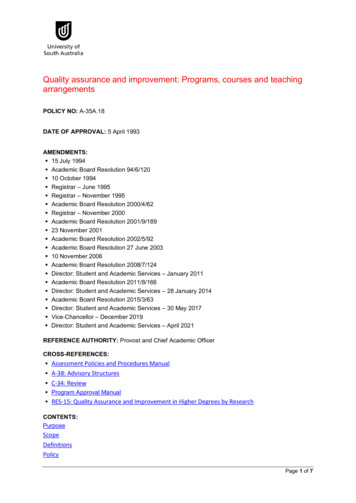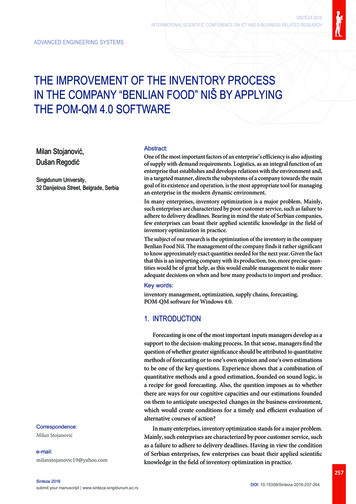
Transcription
SINTEZA 2016INTERNATIONAL SCIENTIFIC CONFERENCE ON ICT AND E-BUSINESS RELATED RESEARCHADVANCED ENGINEERING SYSTEMSTHE IMPROVEMENT OF THE INVENTORY PROCESSIN THE COMPANY “BENLIAN FOOD” NIŠ BY APPLYINGTHE POM-QM 4.0 SOFTWAREMilan Stojanović,Dušan RegodićSingidunum University,32 Danijelova Street, Belgrade, SerbiaAbstract:One of the most important factors of an enterprise’s efficiency is also adjustingof supply with demand requirements. Logistics, as an integral function of anenterprise that establishes and develops relations with the environment and,in a targeted manner, directs the subsystems of a company towards the maingoal of its existence and operation, is the most appropriate tool for managingan enterprise in the modern dynamic environment.In many enterprises, inventory optimization is a major problem. Mainly,such enterprises are characterized by poor customer service, such as failure toadhere to delivery deadlines. Bearing in mind the state of Serbian companies,few enterprises can boast their applied scientific knowledge in the field ofinventory optimization in practice.The subject of our research is the optimization of the inventory in the companyBenlian Food Niš. The management of the company finds it rather significantto know approximately exact quantities needed for the next year. Given the factthat this is an importing company with its production, too, more precise quantities would be of great help, as this would enable management to make moreadequate decisions on when and how many products to import and produce.Key words:inventory management, optimization, supply chains, forecasting,POM-QM software for Windows 4.0.1. INTRODUCTIONForecasting is one of the most important inputs managers develop as asupport to the decision-making process. In that sense, managers find thequestion of whether greater significance should be attributed to quantitativemethods of forecasting or to one’s own opinion and one’s own estimationsto be one of the key questions. Experience shows that a combination ofquantitative methods and a good estimation, founded on sound logic, isa recipe for good forecasting. Also, the question imposes as to whetherthere are ways for our cognitive capacities and our estimations foundedon them to anticipate unexpected changes in the business environment,which would create conditions for a timely and efficient evaluation ofalternative courses of action?Correspondence:Milan za 2016submit your manuscript www.sinteza.singidunum.ac.rsIn many enterprises, inventory optimization stands for a major problem.Mainly, such enterprises are characterized by poor customer service, suchas a failure to adhere to delivery deadlines. Having in view the conditionof Serbian enterprises, few enterprises can boast their applied scientificknowledge in the field of inventory optimization in practice.257DOI: 10.15308/Sinteza-2016-257-264
SINTEZA 2016INTERNATIONAL SCIENTIFIC CONFERENCE ON ICT AND E-BUSINESS RELATED RESEARCHThe subject of our research is the optimization ofinventory in the company Benlian Food Niš. The management of the company finds it rather significant to knowapproximately exact quantities needed for the next year.Although it is a very successful enterprise, the predictionprocess is based on the reasoning and opining of themanagement of the enterprise. Given the fact that thisis an importing company with its production, too, moreprecise quantities would be of great help, because in sucha way, management would be making more adequatedecisions on when and how many products to importand produce.For that very reason, the basic goal of the paper ispoint at the advantages and benefits which the enterprise can achieve by applying a conventional approachto prediction, mainly focused on the development andtesting of statistical techniques. In that sense, softwarepackages developed as a support to the multiple criteriaanalysis models are also a significant segment.2. THE CHOICE OF INVENTORYOPTIMIZATION SOFTWAREThe contemporary conditions of business doing haveimposed upon enterprises basing their business doingon an adequate information support. Without adequateinformation solutions, there is no cost-effective or profitable business doing of enterprises in the turbulent environment, either. The advancement of technology hashad such an impact leading to the emergence of differenttypes of information systems for different fields of business doing inside an enterprise.The movement of goods must be supported by aninformation system. When right goods move towards theright place and at the right time and in right conditions,with right documents, right information, i.e. answers to all“right” questions must be known (Regodić, 2010, p. 359).Given the fact that the business doing of an enterpriseincludes many activities, there are general informationsystems and specialized IT solutions. When supply, thelogistics of inventory and shipment are concerned, information technologies may accelerate the processes,reduce costs and thus be the enterprise’s success factor.“Software must be in function of joint work on the rationalization of the production-business processes, butalso must be rational by itself: with a few input data andcapable of generating purposeful management information.” (Stanišić & Regodić, 2009, p. 93).Planning not supported by computers is impossible incontemporary enterprises. However, integral computertools are mainly expensive (sometimes, they may evencost several tens of thousands of euros). Apart from this,program solutions require more powerful hardware andsoftware as well as a database system in the process of theimplementation of a program solution in an enterprise.A problem may occur in smaller enterprises unable toafford expensive software solutions, so the quality of theirplanning is also frequently questionable. Minor programsolutions supportive of the complex calculations of planning are helpful in planning and are also an interestingtool. At the same time, they are very powerful computertools not specially demanding in terms of the computerperformances and big capacities of the memory.Logistics information systems are impossible to doresearch into, develop and introduce in operating practice (apply) unless there is knowledge of the importantfeatures of quality information systems. Quality information systems supporting the logistic aspects of decisionmaking and supporting the work done by the logisticsbodies cannot be developed unless the information needsof certain users of information systems (information) areadequately defined and unless the objects of the interestof a logistics system are described in as many details aspossible (Andrejić, Milenkov, Sokolović, 2010, p. 34).In the context of inventory optimization, we shalluse the POM-QM solution for Windows in this paper.For the time being, 4.0 is the latest version of this program solution. It should also be emphasized that thereare similar software solutions in the market, as well as alarge number of different types. Some are available freeof charge on the Internet, and some are possible to obtainfor just a few euros.The first version of this software was a DOS versionthat appeared in 1989, as the PC-POM. The followingDOS versions were named AB:POM. The first Windowsversion, the QM for Windows (Version 1.0) was distributed in the autumn of 1996, as a special but similarprogram. The POM for Windows (Version 1.1) was distributed in the autumn of 1996 for the first time. The DSfor Windows version included the POM and the QMmodules and, together with the instructions for use, itwas distributed in 1997. The Version 2 of all the threeprograms was created for Windows 95 and appeared inthe autumn of 1999. (Weiss, 2010, p. vii). The upgradedversion of the POM-QM for Windows 4.0 came to fruition during 2010, and it is possible to download it freeof charge on the Internet.11 For more information about this: mer.com/ (4th March2016)258Sinteza 2016submit your manuscript www.sinteza.singidunum.ac.rsAdvanced engineering systems
SINTEZA 2016INTERNATIONAL SCIENTIFIC CONFERENCE ON ICT AND E-BUSINESS RELATED RESEARCHThe POM-QM 4.0 software solution consists of morethan twenty different modules, and it is possible to havesome of them additionally structured as well. Given thefact that there is a large number of complex modules, onlythose that will be used in the paper will be presented inmore detail. This refers to the Inventory and the Forecasting modules.Principally, work with different modules in a softwaresolution is quite similar. The very beginning is based onentering data, only to be followed by solving and finallyinterpreting data. Each of the modules enables the entering of new data (File, New) or work with the existing orsaved data (File, Open). The POM-QM 4.0 software solution has the following modules: the production programplanning, the production line reconciliation, mappingwork on machines, the break-even point analysis/costanalysis, capital investment, help when making decisions,forecasting, the theory of games, goals programing, integrated programing, inventories (storing), term planning,allocation, the experience curve, linear programing, theallocation of production resources, the optimization ofthe order quantity, the Markov analysis, the planningof material needs, networking (the optimization of theroute), productivity, project management (PERT/CPM),quality control, reliability, simulation, statistics (average,variation, standard deviation, normal distribution), shipment problem, waiting queues, and results measuring.Once a module of forecasting is determined, it ispossible to present four submodules through the mainmenu (File, New): Time Series Analysis, Least Squares/Simple and Multiple Regression, Regression Projector,and Error Analysis.When data have been entered, by pressing the button(Solve), the required calculation is initiated. The resultsare displayed in several windows, depending on the selected calculation module: BAS (Mean Error), MAD(Mean Squared Error), Standard Error, MAPE (MeanAbsolute Percent Error).When the Inventory module has been selected, as it isthe case with the module Forecasting on Command (File,New), we are faced with the possibilities of selecting different submodules: the Economic Order Quantity (EOQ)Model, the Production Order Quantity Model, the Backorder Inventory Model, the Production with BackordersModel, Quantity Discount (EOQ) Model, ABC Analysis,Record Point/Safety Stock (Normal Distribution), RecordPoint/Safety Stock (Discrete Distribution).After data have been entered, by pressing the Solvebutton, the calculation itself is initiated. The results canbe displayed in several windows, which depends on theselection of the module. The coverage of the solutiondepends on the complexity of the problem observed.The results in this module are mainly displayed in twowindows.In the first window, the results obtained on the basis ofthe EOQ selected model are displayed: input data (annualneeds, costs of ordering, costs of storing and the price),the optimal order quantity, the maximum inventory level,(average inventory), annual setup costs, annual holdingcosts, unit costs, total costs.As it could have been seen in the shorter presentationof the POM-QM software solution for Windows 4.0,the software is easy to use. Of course, it is necessary thatthere should be the knowledge of the formulation of theproblem and the purpose of solving the same. It shouldalso be pointed out that the POM-QM software solutionfor Windows 4.0 is an attractive tool.Apart from being attractive and easy to use, too, however, it can also be said to have some shortcomings. Weare going to try to list them: The capacity of some of the modules is ratherrestricted (almost all the modules allow using atable of no more than 90 data or tables of up to90 rows and columns); The software solution lacks a database, so eachtime, data need to be entered “manually”; The results of the solution to the problem in thesoftware solution are not visible in the best possible manner when exported, so, in the majorityof cases, it is necessary that their visibility shouldbe improved through other programs; Networking and the exchange of informationwith other tools is not possible, except with Excel, so, in accordance with that, it is impossible toapply in computer networks; The program solution is in the English language. Yet, perceiving all the mentioned shortcomings,it is possible to conclude that the POM-QM software solution for Windows 4.0 is quite a satisfactory tool that can be used in solving problemsin the field of quantitative methods (QM) andproduction and operations management (POM).The software solution is also fully free of chargeand very simple to use, which enables its quickand easy implementation in the enterprise.Based on the said so far, the key reasons that havecontributed to the selection of the software are: (1) thefunctionalities are sufficient for the application of simpleinventory models as is the one applied in the paper; (2)259Sinteza 2016submit your manuscript www.sinteza.singidunum.ac.rsAdvanced engineering systems
SINTEZA 2016INTERNATIONAL SCIENTIFIC CONFERENCE ON ICT AND E-BUSINESS RELATED RESEARCHthe software is relatively easy to use; (3) the software iscost-effective because it is free to use.3. THE RESULTS AND DISCUSSIONThe company Benlian Food doo (limited liability company) was founded by Raffi Benlian in Niš in June 2001,when its main activity was the import and distribution of,first of all, granular, basic provisions. The company is partof an international group doing business on the territoryof Central Europe and the Balkans, and in that way, itkeeps up with the world trends, which they are trying tobring onto the Serbian market in the best possible way.The company has quite a wide portfolio. The mainactivity is the import
program. The POM for Windows (Version 1.1) was dis - tributed in the autumn of 1996 for the first time. The DS for Windows version included the POM and the QM modules and, together with the instructions for use, it was distributed in 1997. The Version 2 of all the three programs was created for Windows 95 and appeared in the autumn of 1999. (Weiss, 2010, p. vii). The upgraded


